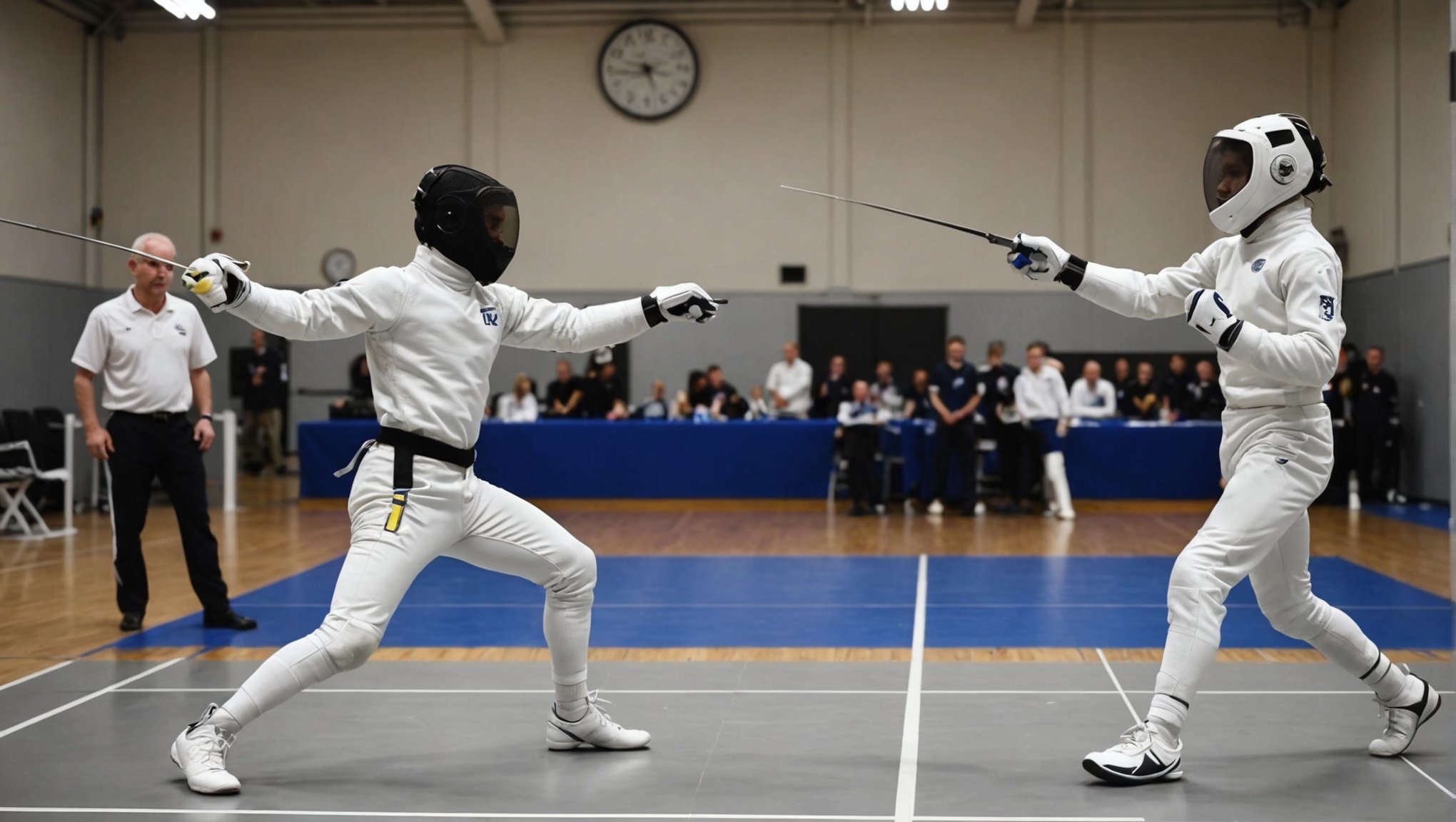Fencing requires razor-sharp reflexes and split-second decisions. UK athletes constantly seek innovative methods to sharpen their reaction times during competition. From high-tech training tools to tailored mental strategies, they adopt a multi-faceted approach to enhance speed. Discover how these elite fencers combine physical conditioning and cognitive training to gain a competitive edge. This exploration offers valuable insights for athletes in any sport looking to improve their quickness and agility.
Techniques to Enhance Reaction Times
Achieving optimal reaction time improvement is crucial for fencing athletes, particularly those in the UK who aim to excel in the sport. Fencers employ a variety of techniques to sharpen their reflexes and enhance their overall performance. Among these, agility and speed stand out as essential components.
Also read : Unpacking Sponsorship Dynamics in the UK Combat Sports Arena: A Comprehensive Guide
Agility allows fencers to swiftly change direction and adapt to their opponents' movements. This is achieved through drills that focus on lateral movements and rapid pivots. Speed, on the other hand, is developed through exercises that emphasize quick bursts of movement, enabling fencers to deliver and defend against attacks with precision.
Footwork plays a pivotal role in improving reaction times. Proper footwork ensures that an athlete can maintain balance and control while moving at high speeds. Techniques such as the lunge, advance, and retreat are fundamental in training sessions, as they help fencers position themselves advantageously during bouts.
Additional reading : Top Strategies for Effective Management of Shoulder Injuries in Judo Practitioners Across the UK
By integrating these fencing techniques, athletes can significantly enhance their reaction times, giving them a competitive edge in the fast-paced environment of fencing.
Training Regimens for Fencing Athletes
Fencing athletes require rigorous fencing training and athletic conditioning to excel. Specific drills are designed to sharpen reflexes, ensuring quick reactions during bouts. These drills often include simulated fencing scenarios that mimic real match conditions, helping athletes anticipate and respond swiftly to their opponents' moves.
Incorporating plyometrics and strength training into a fencer's routine is essential. Plyometrics, which involve explosive movements like jumps and bounds, enhance muscle power and speed. Strength training, on the other hand, builds endurance and stability, crucial for maintaining form and executing precise movements during long matches.
The frequency and duration of training sessions are vital for achieving optimal results. Typically, fencing athletes engage in training 4-6 times a week, with sessions lasting between 1-3 hours. This consistent regimen allows them to build and maintain the necessary physical and mental acuity required for fencing. Regular assessment and adjustment of these sessions ensure that athletes continue to progress and address any weaknesses.
Psychological Strategies for Enhanced Performance
In the realm of fencing, mental conditioning is as crucial as physical prowess. Elite fencers often employ visualization techniques to mentally rehearse their moves and strategies. This practice helps athletes anticipate their opponents' actions and plan their responses, creating a mental blueprint for success.
Sports psychology emphasizes the importance of maintaining focus and concentration, especially under pressure. Fencers are trained to block out distractions and maintain a clear mind during bouts. This mental discipline allows them to react swiftly and make strategic decisions in the heat of competition.
Building mental resilience is vital for fencers facing competitive scenarios. By simulating high-pressure situations during training, athletes learn to cope with stress and remain composed. This resilience not only enhances their performance but also boosts their confidence, enabling them to excel in challenging environments.
Scientific Insights on Reaction Time
Understanding the science behind reaction time is pivotal for athletes seeking to enhance their performance. Sports science delves into the various factors that influence reaction times, providing valuable insights for improvement. Research studies have shown that reaction times are affected by a combination of genetic, environmental, and psychological factors. For instance, studies indicate that age and fatigue can significantly slow down an individual's response, while regular training and mental conditioning can lead to improvements.
In the realm of reaction time research, the analysis of neurological processes plays a crucial role. Quick decision-making in sports involves complex interactions between the brain and the body. The brain processes sensory information and sends signals to muscles to execute movements. This process, known as the sensorimotor pathway, is essential for athletes to respond swiftly to stimuli. Enhancing this pathway through targeted training can lead to faster and more accurate responses.
The implications of improved reaction times extend beyond mere speed. Enhancements in reaction time can lead to better strategic decisions and increased efficiency during performance. Athletes with superior reaction times can anticipate opponents' moves more effectively, providing them with a tactical advantage. By leveraging the findings from sports science, athletes can tailor their training regimens to address specific areas of improvement, ultimately boosting their overall performance.
Practical Exercises and Drills
Enhancing reaction times in fencing requires a focused approach to fencing drills and skill development. Here's a step-by-step guide to essential drills that can significantly improve performance:
Essential Reaction Time Drills
- Mirror Drill: Pair up with a partner and mimic their movements as closely as possible. This drill enhances your ability to anticipate and react to an opponent's actions.
- Ball Drop Drill: Have a partner drop a tennis ball from shoulder height. Your task is to catch it before it hits the ground, improving your hand-eye coordination and speed.
- Shadow Fencing: Practice fencing movements without an opponent, focusing on speed and precision. This allows for the refinement of technique and quick decision-making.
Incorporating Drills into Training
- Consistency is Key: Integrate these drills into your routine at least twice a week to see noticeable improvements.
- Progressive Difficulty: Start with basic drills and gradually increase complexity as your skills develop.
- Feedback and Adjustment: Record your sessions or work with a coach to receive constructive feedback and make necessary adjustments.
By incorporating these practical exercises into your training regimen, you'll enhance your fencing skills and reaction times, giving you a competitive advantage.
Expert Insights and Testimonials
In the world of fencing, coaching tips are invaluable for athletes striving to improve their performance. Leading fencing coaches in the UK emphasize the importance of personalized training plans. These plans are tailored to each athlete's strengths and weaknesses, ensuring focused development. Coaches often highlight the significance of mental preparation alongside physical training, advising athletes to engage in visualization and mindfulness exercises to enhance concentration and reduce anxiety during competitions.
Athlete experiences provide a unique perspective on the journey of mastering fencing. Many athletes recount their struggles with balancing intense training schedules and personal commitments. They share stories of perseverance and the satisfaction of overcoming these challenges. Personal accounts reveal that adaptability and resilience are crucial traits for success. Athletes often credit their progress to supportive coaching and the camaraderie within their training groups, which fosters a motivating environment.
Common challenges faced by top fencers include managing competition stress and maintaining peak physical condition. Solutions implemented by successful athletes often involve a combination of strategic rest periods and cross-training activities to prevent burnout and injuries. Embracing a holistic approach to training, which includes nutrition, mental conditioning, and recovery, is frequently cited as a key factor in achieving and sustaining high performance levels.













